If you want to do a good job in cryptocurrency contracts and want to have a correct logic and method for opening and closing orders, then you are blessed today. This method can help you do a good job in contracts.
If you only have 5,000 yuan in capital and want to reach the million-yuan threshold by rolling over your positions, this article will explain the specific path - it's not based on luck, but on a combination of "increasing positions with floating profits + low leverage + iron discipline." Each step has replicable operational details.
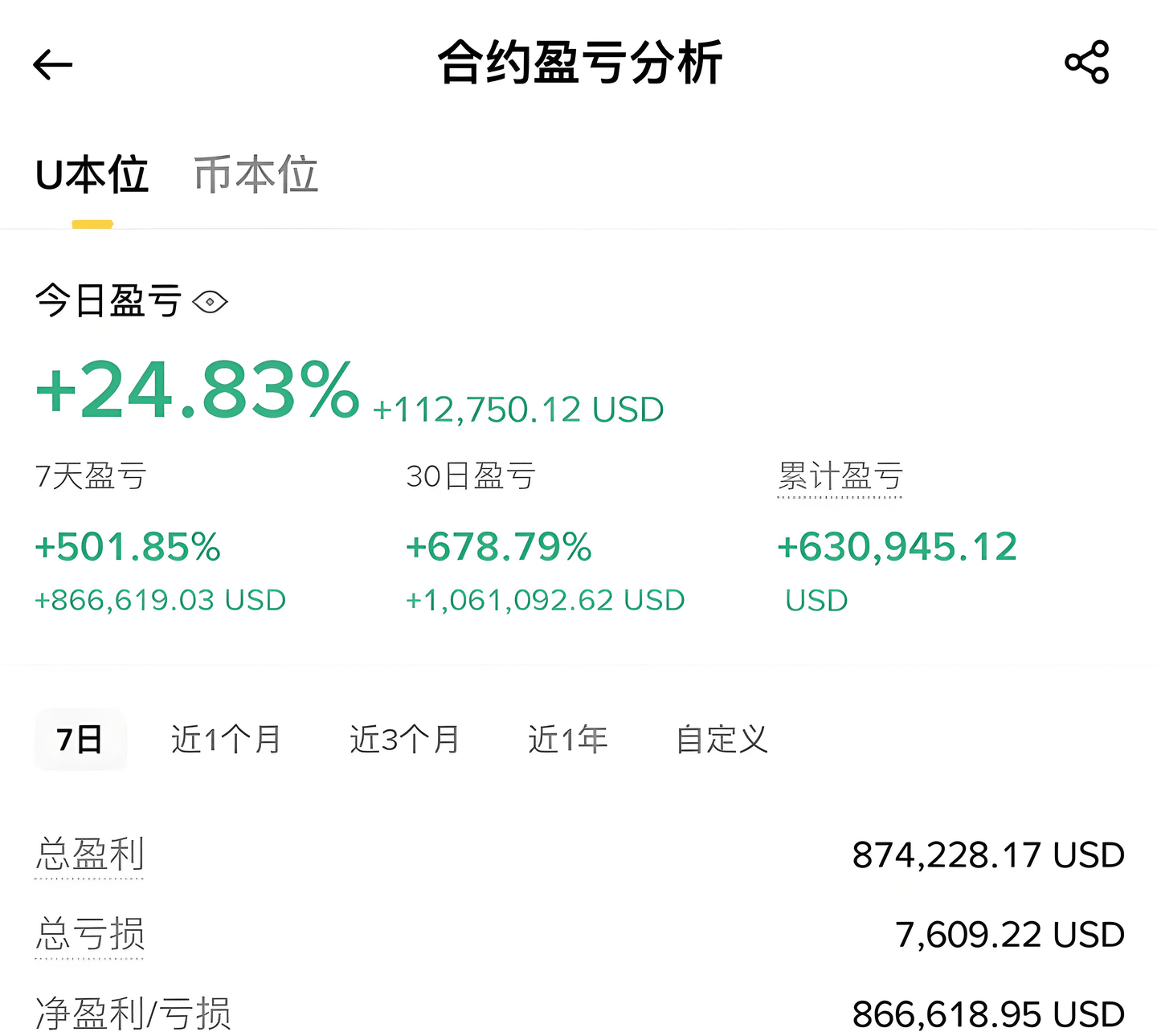
First, understand: Rolling is not "leveraging to bet on the size of the position" but "using profits to snowball"
Many people mistake rolling for "full leverage and aggressive trading." This is a fatal misunderstanding. The true essence of rolling lies in eight key words: add to your position with unrealized profits and lock in risk.
Simply put: Use profits earned from your principal to expand your position, and your principal remains safe. It's like rolling a snowball: First, push with your hand (the principal) to get the snowball moving. Once it builds momentum (and creates unrealized profits), you let the snow (the profits) stick to it. The snowball grows bigger and bigger, but your hand (the principal) never gets sucked in.
For example:
With a 5,000 yuan capital and 10x leverage in isolated position mode, only 10% of the capital (500 yuan) is used as margin to open a trade, effectively using 1x leverage (500 yuan x 10x = 5,000 yuan, equivalent to the principal). With a 2% stop-loss, the maximum loss is 100 yuan (5,000 yuan x 2%), which has minimal impact on the principal.
If you earn 10% (500 yuan), your total capital will be 5,500 yuan. You can use another 10% (550 yuan) to open a trade, still using 1x leverage, and set a 2% stop-loss (a loss of 110 yuan). Even with this stop-loss, your total capital will be 5,500 - 110 yuan = 5,390 yuan, a profit of 390 yuan compared to your initial profit.
This is the underlying logic of rolling positions: using profits to cover risks, ensuring the safety of principal. High leverage, "pseudo-rolling" with principal added to positions, is essentially gambling and will eventually lead to a margin call.
2. Three life and death lines for rolling positions: Hit one and 5,000 can turn into millions
The key to rolling over isn't how quickly you make money, but how long you can survive. I've seen people roll 5,000 yuan to 800,000 yuan, and I've also seen people roll 100,000 yuan into a negative number. The core difference lies in three disciplines:
1. Leverage must be "ridiculously low": 3x is the upper limit, 1-2x is more stable
"The higher the leverage, the faster you make money"—this is the most common pitfall for beginners. In 2022, I met a retail investor who used 20x leverage to roll over a 5,000 yuan capital position. He made 3,000 yuan on the first roll. After adding to his position a second time, he encountered a spike and his position was wiped out.
Remember: rolling over relies on "compounding," not "single exorbitant profits." 3x leverage means a 33% fluctuation before liquidation, combined with a 2% stop-loss, offers significant margin for error. Meanwhile, 10x leverage could trigger forced liquidation at just 10% fluctuation, making it difficult to withstand the normal fluctuations of the cryptocurrency market.
My suggestion: Use 1-2x leverage in the early stage. After making profits for 5 consecutive times and having a stable mentality, increase it to 3x. Never touch more than 5x.
2. Only use "floating profits" to increase your position: the principal is your trump card and must not be touched
The essence of rolling a position is "making money with the market's money." For example, if you have a 5,000 yuan principal and your first profit is 1,000 yuan, your total capital will become 6,000 yuan. At this point, you can only use a maximum of 1,000 yuan of the floating profit to increase your position, and your 5,000 yuan principal will not be touched.
This way, even if you lose money by adding to your position, at most you’ll lose your floating profit, and your principal will remain safe. On the other hand, if you invest all your 5,000 yuan, a single misstep will return you to square one, and all your previous efforts will be wasted.
It’s like a fisherman fishing: he uses the fish he caught as bait, and even if he doesn’t catch any new fish, he won’t lose his fishing boat.
3. Stop-loss must be “iron and cold-blooded”: 2% is the red line, cut it when it reaches that point
"Wait a little longer, maybe it'll rebound"—this statement can ruin any rolling plan. When rolling, the stop-loss for each trade must be strictly controlled within 2% of the total capital. For a 5,000 yuan capital, this is 100 yuan, and for a 100,000 yuan capital, it is 2,000 yuan. Cut losses immediately at that point. No excuses.
In 2023, Bitcoin surged from $30,000 to $40,000. I rolled my position with 1x leverage, using three stop-loss orders, each resulting in a loss of 1,000-2,000 yuan. However, the six profits ultimately tripled my total investment. If I had held onto my position during one of these stops, I would have been wiped out by the volatility and missed the subsequent uptrend.
3. From 5,000 to 1,000,000: Three-stage rolling strategy with specific operations for each step
To grow from 5,000 yuan to 1 million yuan, you need to advance in stages, with different goals and strategies at each stage. It's like climbing a staircase: if you take three steps at a time, you'll fall. Only by taking one step at a time can you reach the top.
Phase 1: 5,000 → 50,000 (accumulating start-up capital and gaining experience)
Core goal: Use spot trading + small leverage to familiarize yourself with the rhythm and accumulate the first amount of "stress-free funds".
First, use 5,000 yuan to do spot trading: buy BTC and ETH at the low point of the bear market (for example, when BTC falls to 16,000 in 2023), and sell them when they rebound by 10%-20%. Repeat this 3-5 times and roll the funds to 20,000.
Use 1x leverage rolling: When BTC breaks through key resistance levels (e.g., 20,000 or 30,000), open a long position with 1x leverage. If you achieve a 10% profit, use your floating profit to add another 10% to your position. Set a 2% stop-loss. For example, with a 20,000 yuan capital, open a 2,000 yuan position. After a 200 yuan profit, add another 200 yuan to your position, keeping your total position below 10% of your principal.
Key: Don’t pursue speed at this stage. Focus on practicing the muscle memory of “stop loss + increase position with floating profit” and complete at least 10 profitable trades before entering the next stage.
Phase 2: 50,000 → 300,000 (capture the trend and maximize profits)
Core goal: Increase the frequency of rolling positions in a clear trend and speed up by "band compounding".
Only trade during a "deterministic trend": For example, when BTC's daily chart stabilizes above its 30-day moving average and trading volume increases by more than 3 times, confirm an upward trend before rolling over. After the BTC ETF is approved in January 2024, it will be a typical trending market, suitable for rolling over.
Increase your position: For every 15% profit, add 30% of the floating profit to your position. For example, if your initial capital of 50,000 yuan increases by 15% to 57,500 yuan, add 2,250 yuan (30% of the floating profit of 7,500 yuan) to your position, keeping your total position within 20% of your initial capital.
Profit-taking strategy: For every 50% increase in the stock price, take 20% of the profit. For example, if your stock price goes from 50,000 to 100,000, withdraw 20,000 in cash and keep the remaining 80,000 rolling. This locks in profits while avoiding the psychological collapse of "profit-taking."
Phase 3: 300,000 → 1,000,000 (relying on the big cycle trend to earn the "era dividend")
Core goal: seize the big market trend of bull-bear transition and complete the transition with a big trend.
Waiting for a "historic opportunity": For example, when Bitcoin rises from a bear market bottom (e.g., $15,000) to a mid-bull market (e.g., $60,000), this 5x trend can magnify returns by more than 10x. During the 2020-2021 bull market, some people rolled from $300,000 to $5 million, leveraging this megatrend.
Dynamically adjust your position: Initially, maintain a 10%-20% position, increase it to 30%-40% in the middle of a trend, and then reduce it back to 10% in the later stages. For example, if BTC rises from 30,000 to 60,000, start with a 30,000 position, increase it to 60,000 when it reaches 40,000, and then reduce it back to 30,000 when it reaches 50,000. This way, you don't miss out on the main uptrend while mitigating risk at the top.
The ultimate rule: Stop rolling when your funds reach 800,000. Take out 500,000 and deposit it in stablecoins, leaving the remaining 300,000 to continue trading. Remember: the goal of rolling is to "get your money in the bag," not to "keep it rolling forever."
4. The Most Easily Overlooked Thing: The “Mental Moat” of Rolling
To turn 5,000 yuan into a million, skill is only 30% and mindset is 70%. I've seen too many people who have good skills but fail because of two mindset traps:
1. Don’t be greedy for the “perfect increase”: it is better to miss it than to increase it incorrectly
Some people often worry about adding too early or too little. For example, they plan to add to their position when their profit reaches 10%, but rush to add when it reaches 9%, or wait for a correction when it reaches 15%. In reality, rolling doesn't require precision; as long as you add to your position within the "profit range," you're not wrong.
Just like farming, as long as you sow in spring, it doesn’t matter if you sow a few days earlier or later, it is better than missing the sowing period.
2. Accept “imperfect stop loss”: stop loss is a cost, not a failure
During a rollover, it's normal to have 3-4 stop-loss orders out of 10 trades. In 2023, I rolled my SOL positions and had stop-loss orders on 2 of 5 trades, but the remaining 3 trades were profitable, increasing my total capital by 80%.
Think of stop loss as "buying a ticket" - if you want to enter an amusement park, you have to buy a ticket. If you occasionally encounter an unfun project, you cannot get a refund, but it will not affect your enjoyment of other projects.
5. 3 practical examples of rolling over 5,000 yuan: Don’t fall into the traps others have stepped on
Positive Case: 5,000 yuan → 780,000 yuan, relying on the "stupid method"
From 2022 to 2024, someone started with 5,000 yuan in spot trading, buying ETH (at $880) during a bear market and selling it when it rose to $1,200, earning a 40% profit. He then rolled over his position using 1x leverage, adding another 10% every time he made a 10% profit, with a 2% stop-loss. Over two years, his profit reached 780,000 yuan. His secret: trading exclusively in ETH, avoiding altcoins and never switching between currencies. His success hinged on a combination of focus and discipline.
Bad Case: 100,000 to 500 yuan, death from "leverage addiction"
In 2023, a retail investor rolled over their 100,000 yuan position with 5x leverage. After making 50,000 yuan in the first two trades, they increased their leverage to 10x. However, BTC plummeted, leaving them with only 30,000 yuan. Undeterred, they added another 10x leverage, only to lose everything a week later. They had committed the cardinal sin of rolling over: using their principal to increase their position, increasing their leverage.
Key conclusion: The essence of rolling is "trading time for space"
Going from 5,000 yuan to 1 million yuan requires at least two to three cycles of bull and bear markets (three to five years). Those who dream of achieving it in one year will eventually be taught a lesson by the market. The secret to wealth in the cryptocurrency world has never been "fast," but rather "stable and long-term."
Finally: The enlightenment of rolling warehouse to ordinary people
Can 5,000 yuan be rolled into 1 million yuan? Yes, but three prerequisites must be met:
Use spare money to operate, and losing it all will not affect your life;
Spend at least 6 months practicing your skills and complete 100 simulated trades;
Accept "slowness" and don't pursue overnight wealth.
Rolling isn't a myth; it's a tool for ordinary people to achieve success through discipline. It's like climbing a staircase: each step may seem ordinary, but if you persist for 1,000 steps, you can reach heights that others can't reach.
If you only have 5,000 yuan now, don’t worry, start with the first profit of 100 yuan and start rolling it up - the snowball of wealth always starts with a small snowball.
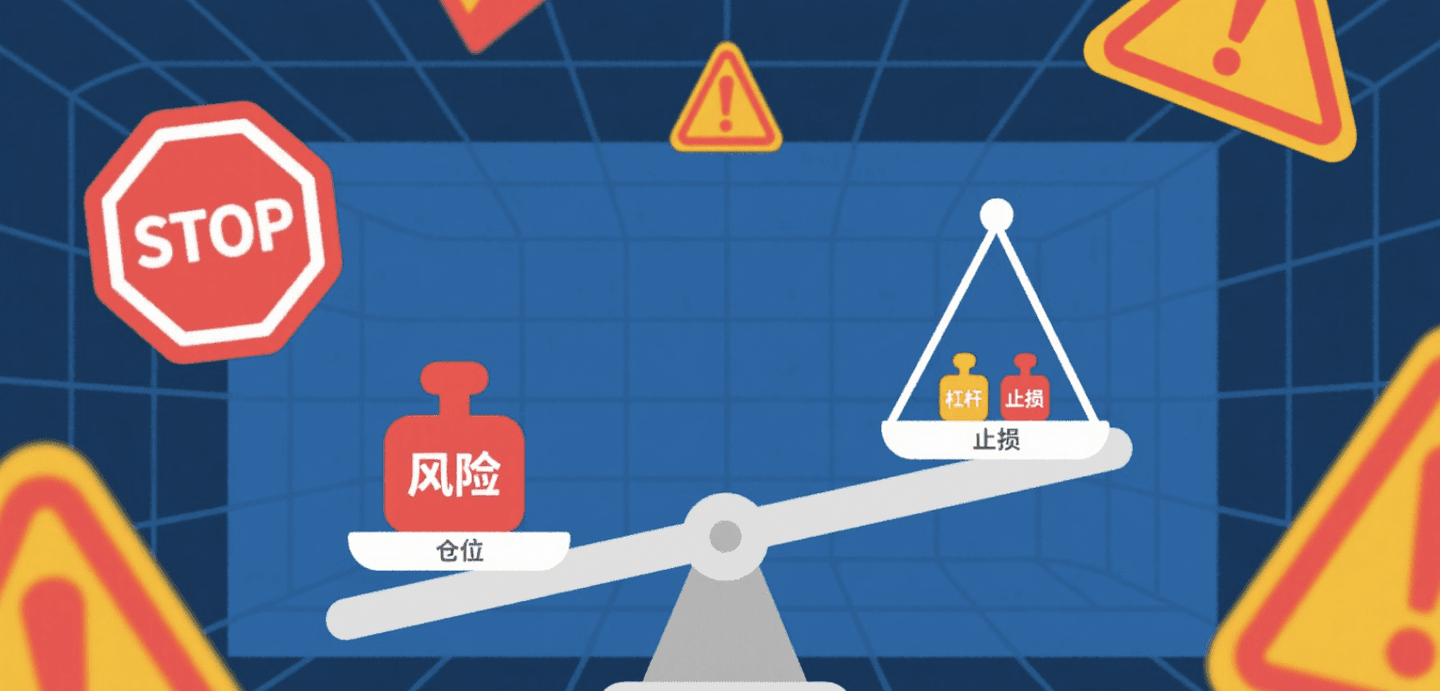
Want to gain a firm foothold and achieve sustained profitability in futures trading? These six key points will help you clarify your thinking and avoid detours:
1. Understand the market thoroughly and focus on areas of expertise
Don't just focus on candlestick charts. First, understand the underlying logic of fundamentals and technical analysis to clearly identify the driving factors behind the trend. Only trade stocks you've thoroughly researched, closely monitor their trends, and avoid being distracted by unfamiliar market trends.
2. Before trading, draw up a "battle map"
Before opening a position, you must clearly consider: When should you enter? What is the maximum loss level at which you should exit? What is the maximum profit level at which you should stop? Use a clear plan to guide your operations and avoid letting your emotions dictate your actions.
3. The string of risk must be kept tight
Stop-loss and take-profit aren't just for show; they're a line of defense to protect your capital. Do what's best for your capital, and don't increase your position or leverage arbitrarily. Only by avoiding gambling and greed can you survive long-term.
4. Market conditions are volatile, so strategies must be adaptable.
There's no such thing as a permanent solution. When the market trend changes, your thinking needs to adapt. Don't hesitate when it's time to cut, and don't be greedy when it's time to cash in. Being flexible is more effective than stubbornly holding on.
5. Real progress comes from practical experience
Learning theory from books is the foundation, but true skill comes from practicing through repeated trading. Reviewing your trades while you trade helps you understand your strengths and weaknesses, and gradually develop a strategy that works for you.
6. Only when your mind is stable can your profits be stable
In the end, trading is all about mindset. Don't let one or two gains or losses throw you off balance, don't dream of getting rich overnight, and treat every fluctuation with a normal mindset. When your expectations are reasonable, your actions won't be distorted.
Ultimately, contract trading isn't a matter of luck; it's a journey of continuous refinement. Only by maintaining discipline, managing risk, maintaining a steady mindset, and using sound strategies to manage every penny can you navigate the market steadily and achieve long-term success.
To make $1 million in the cryptocurrency world, you either have to rely on a bull market and hold on, or you have to bet on a lucky coin, or you have to use high leverage to bet on the right direction. But most people lose money, so don’t just rely on the get-rich-quick stories; first determine how much risk you can tolerate.
If you are also a fan of cryptocurrency technology, click on the coin homepage.
Click on the avatar to follow me and get first-hand information and in-depth analysis!

After 10 years of cryptocurrency trading, I've personally tested this method: the 20 EMA. A powerful 15-minute short-term trading tool: a high-probability trend strategy even for beginners. In trading, you don't always need an extremely complex or specialized approach to succeed. Instead, you just need an effective strategy. And utilizing one of the oldest and simplest trading tools—moving averages—might be a good place to start.
If you're a scalper or employ other short-term strategies, using moving averages on the 15-minute chart is highly recommended. The 20-day EMA (Exponential Moving Average) is the most effective moving average for the 15-minute chart because it most accurately tracks price movements during multi-day trends. In other words, it allows you to easily identify trends.
How does the 20 EMA strategy work?
The main advantage of the 20 EMA trading strategy is that it is easy to use even for novice traders. The only tool you need is the 20 EMA, and it works on any currency pair and any timeframe.
In a downtrend, prices are generally expected to move lower. However, at some point, you may see prices reverse direction and test the 20 EMA. If the downtrend is strong enough, the 20 EMA will push prices back below it. This phenomenon is called a "retracement," and it may occur once or several times until the 20 EMA is finally broken.
Therefore, the core function of the 20 EMA strategy is to act as a "rebound line" for the candlestick. As a trader, you should wait for and take advantage of the moment when the price retraces to the 20 EMA line.
There's a key detail to note here: You only need to focus on one very specific candlestick—the one that first returns to and touches the 20 EMA after a period of separation. Remember, if the next candlestick continues to move close to the EMA, it's not a good signal. Once you catch the correct signal, it's a good time to enter a position.
For example:
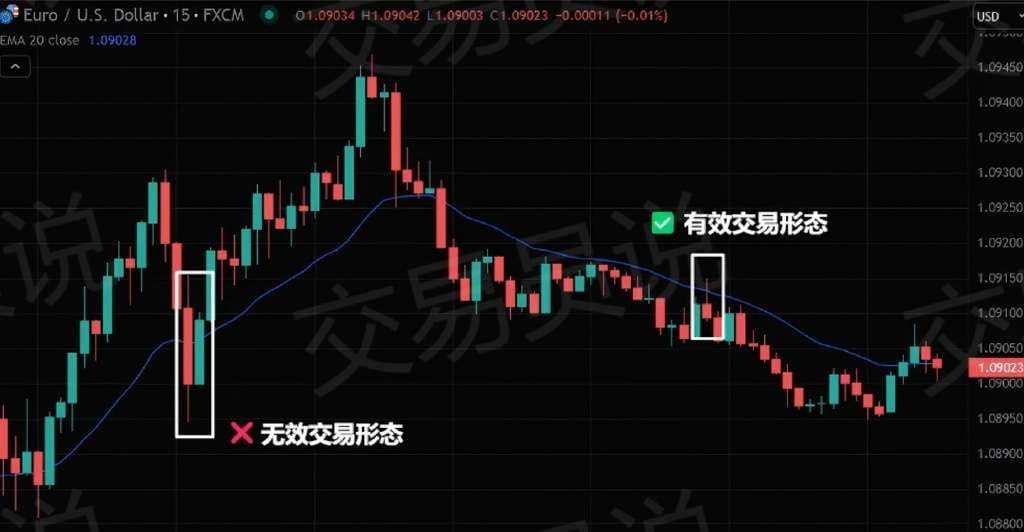
The basic principles of the 20 EMA strategy are as follows:
➡️ When the price closes above the 20 EMA, the market is in an uptrend; when the price closes below the 20 EMA, the market is in a downtrend.
➡️ The first candlestick that touches the 20 EMA after the trend changes direction is called the signal candlestick. You only need to focus on this candlestick, as your entry point is determined by the high and low of this signal candlestick.
➡️ During an uptrend, you should place a buy stop order 1–2 pips above the highest point of the signal candlestick. If the next candlestick does not trigger your order, you should cancel it.
➡️ On the contrary, during a downtrend, you should place a sell stop order 1–2 pips below the lowest point of the signal candlestick. If the next candlestick does not trigger the order, it should be cancelled.
➡️ In a long trade, the stop loss should be set a few pips below the lowest point of the signal candlestick (at least 5–10 pips, depending on the timeframe you are using); in a short trade, the stop loss should be set a few pips above the highest point of the signal candlestick.
Here is an example of opening a short position based on the previous chart:

In the above image, on the EUR/USD 15-minute chart, the signal candlestick's low was 1.09087, so a sell stop-loss order was set two pips below it. The next candlestick continued its decline, so the order was triggered at 1.09067. According to the rule, the stop-loss should be set 10 pips above the signal candlestick, at 1.09167. As for the take-profit, in this case, a 1:2 risk-reward ratio was used, so the take-profit was set 20 pips below the entry price, at 1.08867.
Identifying the Primary Trend Using the Daily Chart
You don't want to risk losing money by jumping into a trade when the trend isn't clear, which is why some traders choose to filter the market by switching to other timeframes. They want to identify the trend ahead of time and make sure it's strong enough. Once they've confirmed the price's direction on the daily chart, it becomes much easier to find entry points on the 15-minute chart.
What to do?
First, to identify a trend, you need to set a few rules on your chart. The goal is to identify the direction the price is moving. Don't worry, these rules apply to both uptrends and downtrends, and they work equally well across different timeframes:
Make sure the price has been rising or falling for several consecutive days and has at least one higher low (HL) in an uptrend and at least one lower high (LH) in a downtrend.
◎ In an uptrend, the 20 EMA line should show an upward angle of 2 o'clock or steeper; in a downtrend, the 20 EMA line should show a downward angle of 4 o'clock.
◎ In an uptrend, the price should significantly break through the resistance level; in a downtrend, the price should significantly fall below the support level.
After this, switch to the 15-minute chart and focus on the following two potential buy conditions on the uptrend:
1. Support/Resistance Breakout on the Daily Chart
If the price is clearly moving along the 20 EMA, it means it is in an ideal trading position.
2. Large fluctuations in support/resistance areas
This is a relatively safer situation because the price has confirmed its momentum and continues to move in the expected direction. Therefore, when the price touches and stabilizes near the 20 EMA, it is a good entry point.
How to use the 20 EMA to find quality entry points
Using the 20 EMA (Exponential Moving Average) to identify a good entry point is relatively simple. First, identify the trend, find support and resistance levels, and then enter the market when the price pulls back to these levels.
1. Identify trends
The process of identifying a trend using the 20 EMA indicator is fairly straightforward. You simply observe the position of the EMA line relative to the current price action.
If the EMA line is below the current price, it indicates an uptrend.
Conversely, if the EMA line is above the current price, it indicates a downtrend.
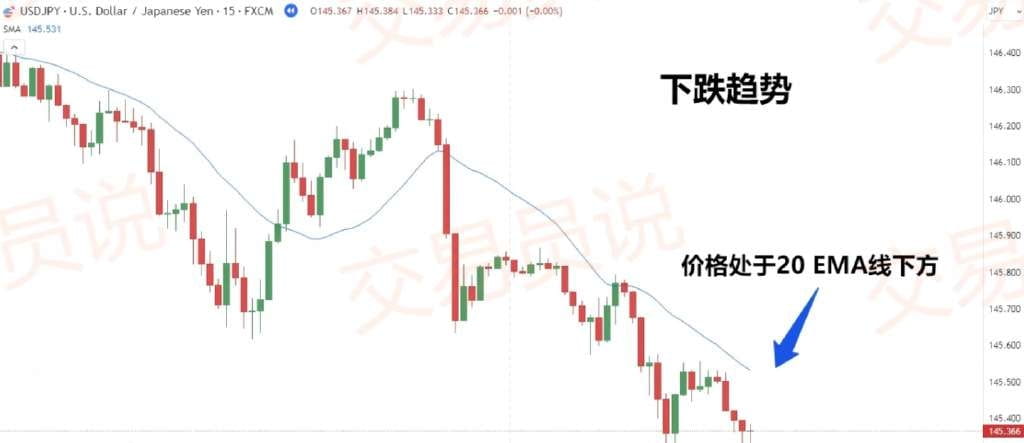
2. Find support or resistance
Once you have identified the current trend, the next step is to identify important support or resistance levels. As previously emphasized, we focus on the dynamic support and resistance coming from the 20 EMA line.
◎ In a downtrend, the 20 EMA line acts as a resistance level.
Conversely, in an uptrend, the 20 EMA acts as a support level.
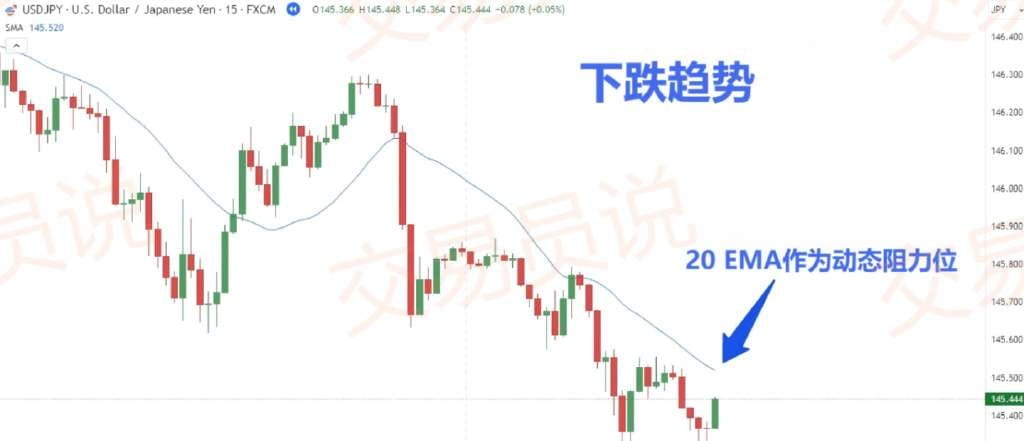
3. Wait for callback
Next, we need to wait patiently for the price to pull back to the support or resistance level, or to pull back to around the 20 EMA line.
This stage is very important and is often overlooked by many novice traders who may think that they can enter the trade immediately once the trend direction is clear.
However, in practice, even if the trend direction is clear, we still need to wait patiently for a retracement. This waiting time is crucial to optimizing the risk-reward ratio of the trade setup.
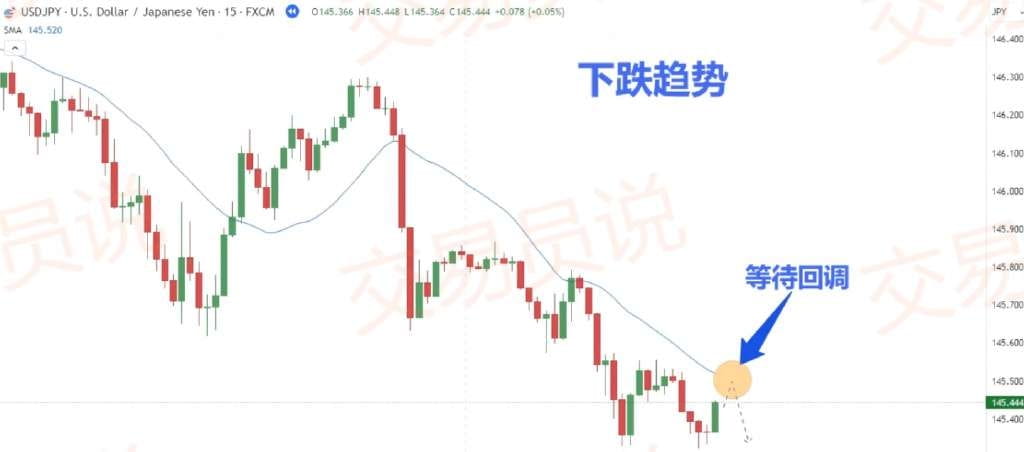
4. Admission confirmation
There are two ways to confirm your entry: using price action or technical indicators.
Price action confirmation: Observe chart or candlestick patterns. Common chart patterns include double tops/bottoms, head and shoulders tops/bottoms, and triple tops/bottoms. Common candlestick patterns include engulfing patterns, pin bars, and inside bars.
◎ Technical indicator confirmation: You can use tools such as stochastic indicators, relative strength index (RSI), MACD, etc.
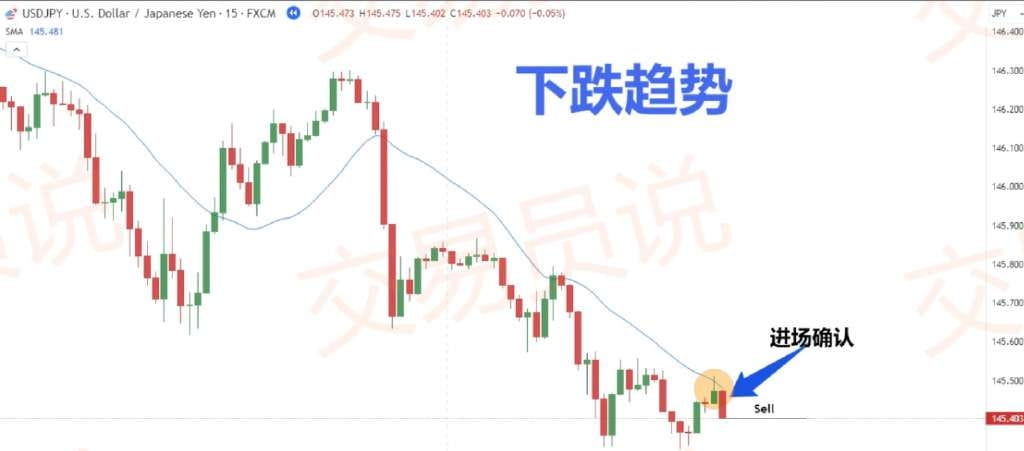
When using this trading strategy, it is important to focus on the following aspects:
1. Enter the market only when it is trending
Entering a trade during a clear, established trend significantly increases the probability of a successful trade. Prices are more likely to continue in their current direction, which helps traders capitalize on existing momentum. Conversely, attempting to trade during trendless or volatile market conditions can lead to unpredictable price movements and potentially unfavorable trading outcomes.
2. Avoid trading against the trend
Trading against the trend carries a higher risk. Trading against the trend means traders are essentially betting that the market will reverse its current direction, which requires precise timing and strong reversal signals.
3. Enter the market during active trading hours
Active trading hours often coincide with major market overlaps, such as when the London and New York markets are open simultaneously. Trading during these hours offers better opportunities due to higher volumes and price volatility, which translates to tighter bid-ask spreads, less slippage, and better trade quality.
Conversely, trading during low activity periods, such as the Asian session, weekends, or holidays, may result in wider spreads and lower liquidity, making trade execution more difficult.
Is the 20 EMA suitable for day trading?
The answer is yes. The 20 EMA is suitable not only for scalping but also for day trading. However, in day trading, you usually need to wait for a specific pattern to appear before entering the market. Once you find such a pattern, you need to use support and resistance levels for confirmation. This pattern is actually very easy to identify.
You should see a strong up or down move within the first two hours, followed by a pullback to the 20 EMA. Remember, for this strategy to be effective, you need to confirm the trend direction on higher timeframes. If the trend on the higher timeframes is consistent with the earlier move, the probability of a price reversal near the 20 EMA is very high.
Will the 20 EMA strategy fail? Backtesting results will tell you
Like any trading strategy, the 20 EMA isn't perfect and can break down. Sometimes, the price will reach a support or resistance level but continue to move sideways. It might even ignore the 20 EMA and fluctuate back and forth. If you encounter this situation, it's best to pause your trade and wait patiently for the next opportunity, as these market conditions are full of uncertainty.
The 20 EMA strategy for day trading was backtested for one week from March 5, 2025, to March 12, 2025. The results showed that although the strategy failed in some cases, it still achieved positive returns overall.
The details are as follows:
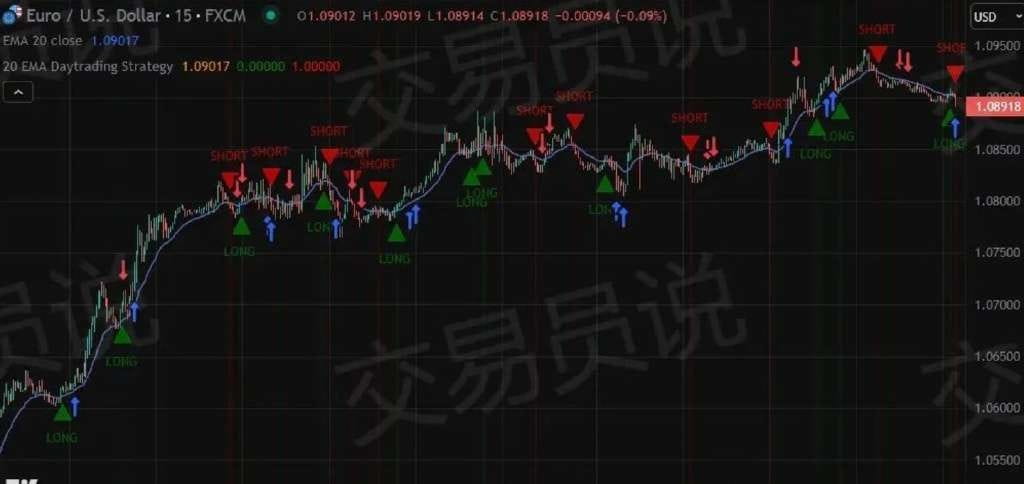
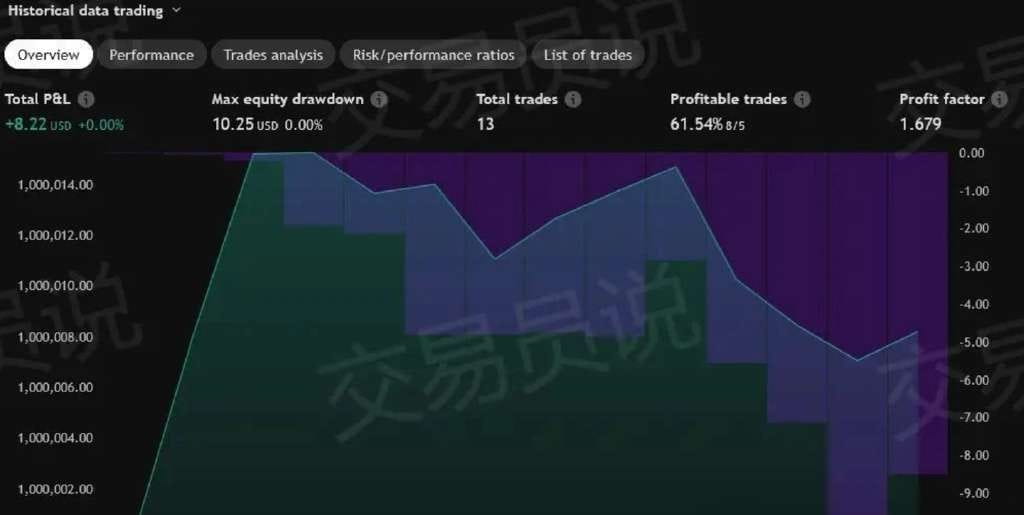
A total of 13 trades were executed over the seven-day period, validating the 20 EMA strategy's value as a day trading system. More importantly, the strategy achieved a 61.54% win rate and generated a total profit of $8.22.
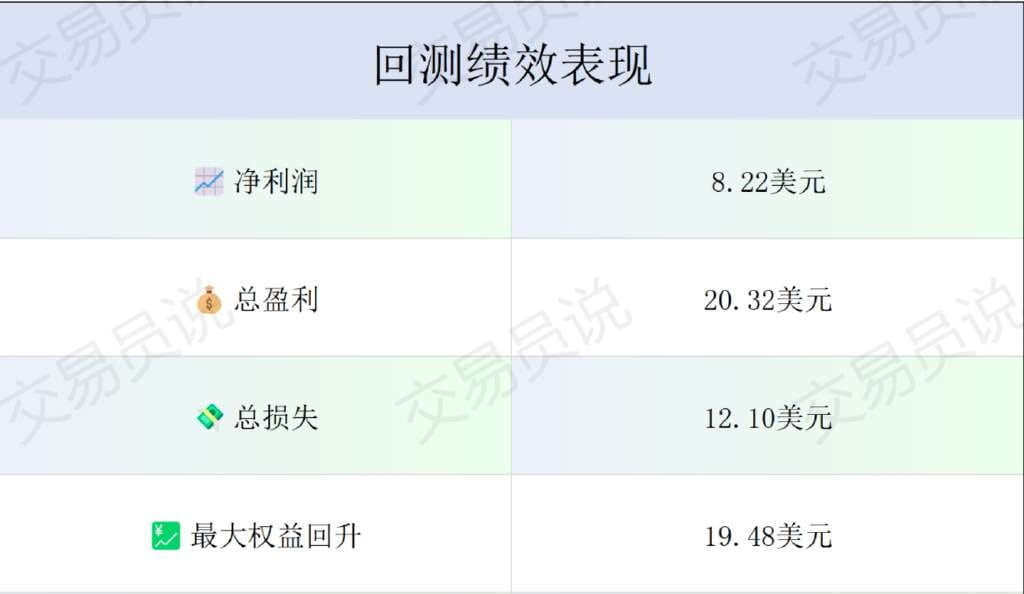
in conclusion
The 20 EMA trading strategy is a simple yet powerful one. Compared to the SMA (Simple Moving Average), the EMA (Exponential Moving Average) follows price fluctuations more closely, resulting in more accurate "bounce lines" on the chart.
This strategy is simple enough for even novice traders to pick up quickly, and it's quite effective when used for short-term trading on the 15-minute chart. However, it's best to confirm the trend on the daily chart first, and keep an eye on support and resistance areas.
Even if the 20 EMA strategy fails at times, you can improve your odds by analyzing multiple timeframes and adding more tools to your charts. Furthermore, if you trade in the direction of the confirmed major trend on the daily chart, your overall probability of profitability remains high.
While it may take some time to fully master this method, it is definitely worth a try. More importantly, you should test the strategy in a demo account before applying it to a live account.
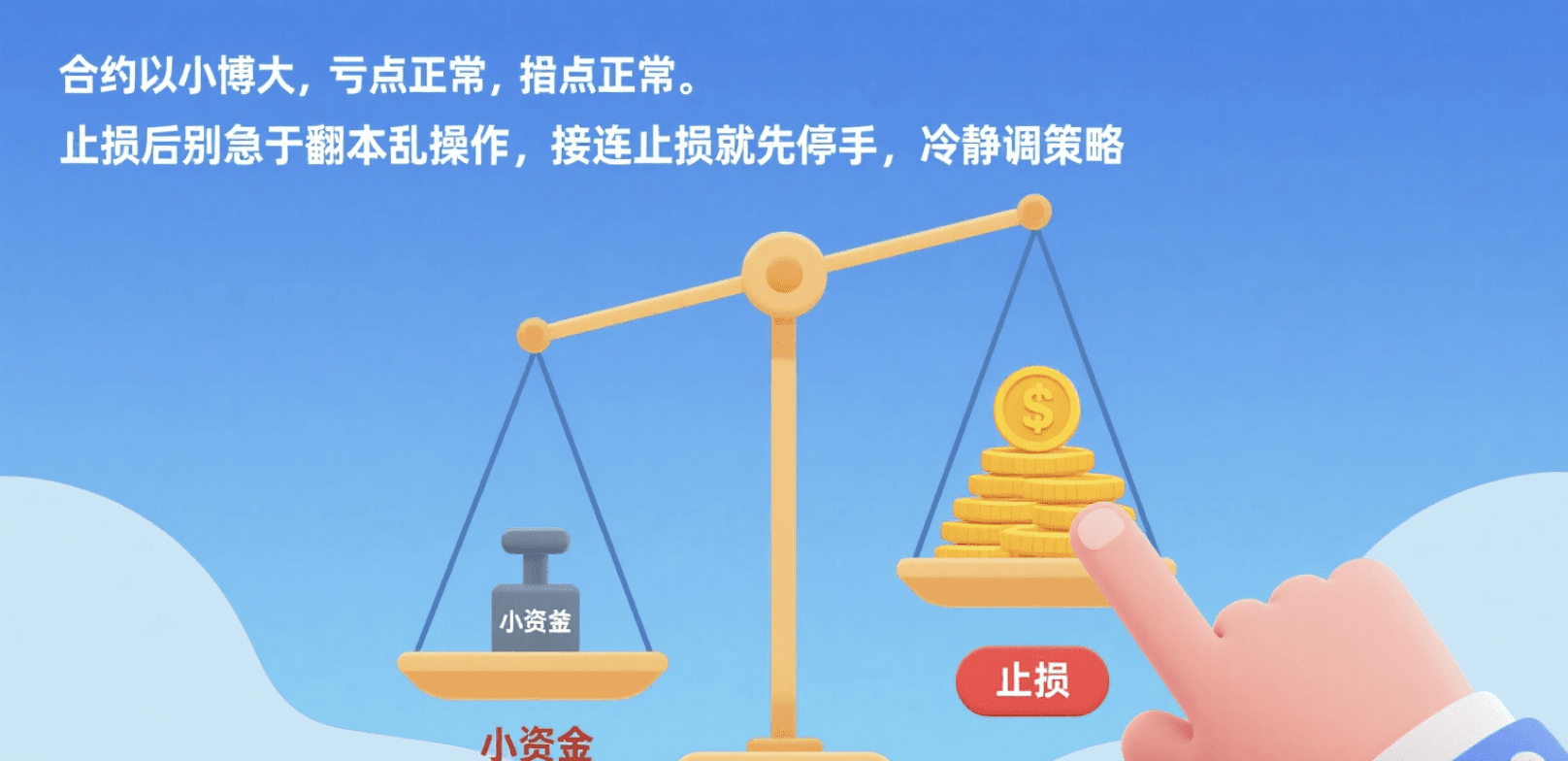
To play with contracts, you must remember these iron rules to help you avoid big pitfalls:
1. Contracts offer a small investment for a big return, so losses are normal. Don't rush to recover losses after setting a stop-loss order. If you experience multiple stop-loss orders, stop trading and calmly adjust your strategy.
2. Don’t expect to get rich overnight through trading. Don’t panic if you lose money, and don’t go all-in to make up for the loss. Keeping a stable mentality is more important than anything else.
3. Only by identifying the general trend can you stand in the right direction. In a one-sided market, you should follow the trend and not go against it. Wait patiently for an opportunity before taking action.
4. Calculate the profit and loss ratio carefully. Only orders with profits that can at least cover 2 times the losses are worth doing and will be sustainable in the long run.
5. Don’t place orders frequently. Newbies should not place orders blindly. Most “opportunities” are traps. The more you place orders, the bigger the mistake.
6. Only make money that you can understand. Don’t touch profits that are beyond your understanding. If you take them, you will have to pay them back or even lose money.
7. Never hold on to a position. Newbies must set a stop loss. Holding on to a position is the first step towards the abyss.
8. Don’t get carried away after making money. It’s easy to become careless when you are complacent. The profits may be lost in minutes. It is more important to hold on to the profits.
To make $1 million in the cryptocurrency world, you either have to rely on a bull market and hold on, or you have to bet on a lucky coin, or you have to use high leverage to bet on the right direction. But most people lose money, so don’t just rely on the get-rich-quick stories; first determine how much risk you can tolerate.
If you are also a fan of cryptocurrency technology, click on the coin homepage.
Click on the avatar to follow me and get first-hand information and in-depth analysis!